
11 – 22 December 2011
Shirley: ‘We are 140 nautical miles from Ushuaia, sailing through a Force 7 gale and 5 metre seas. I suggest you stay in bed for a while.’
It’s 7.30 am and the voice of the expedition leader, Susan, is the first thing we hear. It’s good advice and we don’t take any convincing. The pitching of the MS Expedition in the high seas of the Drake Passage meant fitful sleep, despite our comfortable bunks. Rather than rolling from side to side we have been rolling from top to bottom — feet over the bottom of the bed and then head banging into the headboard. Thank goodness for the seasickness pills we bought in Ushuaia.
At 10 o’clock we’re invited to the ship’s lounge for onboard historian Scott MacPhail’s talk on the Scott and Amundsen race to the South Pole. The centenary of their race will be celebrated in a couple of days on December 14.
We stagger out of bed. I don’t really want to look out the window. It’s bleak out there while we’re quite comfortable in here. Showering and dressing is a bit of a circus act, reeling from one side of the cabin to the other. Luckily the shower stall is tiny so there isn’t much room to move.
In the corridors, large plastic bags are tied to all the railings, just in case. The rule that we must keep one hand for the ship makes a lot of sense as we move along the railing and up the stairs to the lounge. Up here the wide windows make it impossible to ignore the moving horizon and the huge seas. The rolling and pitching is even more pronounced than it is in our cabin.

Scott MacPhail, not to be confused with Scott of the Antarctic, is a veteran of Antarctica tours and says he’ll understand if we doze off. He knows the medication does that. He also suggests leaving as soon as we feel unwell. This is reinforced by another crew member, John Kernan, the marine mammal and biology expert, who tells us about ‘unspeakable’ things he has seen on crossings.
I’m not sure I’m going to last the distance, but we both manage to listen to the story of these two brave explorers without dozing off or throwing up. Afterwards we head back to bed — lunch just doesn’t seem like a good idea. Oh God! I wish we were back on the bike.
•
By dinner time we both need food. The dining room is at the very top of the ship. The only thing above us is the bridge so it’s really rocking and rolling up here. Keeping one hand for the ship isn’t so easy when you have a plate to carry, but we manage to get the food to our table without a mishap. It’s a lot like street theatre watching the waiters carrying huge trays laden with plates across the dining room, running backwards and forwards with the rolling of the ship and leaning at obtuse angles to remain upright. It’s truly performance art at its best. They are unbelievably skilful, yet despite their proficiency, there are a few breakages.
It’s amazing what a difference a meal can make. We both feel a little more human after dinner, but when we are warned the seas might get even bigger overnight we head back to bed and dose up on seasickness medication.
Brian: Our wake up calls brings some good news. The first words Susan says are ‘Welcome to Antarctica’.
We are still a long way from the continent of Antarctica, but overnight we have crossed the Antarctic Convergence, where the Antarctic and the sub-Antarctic waters meet. It’s like an imaginary ring around Antarctica. The water temperature dropped from 4°C to 2°C and is now –1°C. The air temperature is 4°C. We are 146 nautical miles from the South Shetland Islands.
The bad news is that the wind is still at Force 7 with 5 to 6 metre seas.
I convince Shirl to drag herself out of the bunk and come with me to breakfast. It’s a good move. There are a lot more people up and about today. I am certainly feeling better and getting my sea legs.
•
Our improved wellbeing doesn’t last long. We have to go to the mudroom in the bowels of the ship for our waterproof boot and life jacket fitting. It’s hot and humid down here, which is not so good when you are feeling ordinary. Shirl looks very pale and we both skedaddle back to our cabin as soon as we can.
Shirley: I’m wondering where the blue skies and white snow you see in the ads are. Will we ever reach calm waters? Today is Wednesday, December 14, the 100th anniversary of Amundsen reaching the South Pole. We’re woken with the news that the Force 7 winds are still with us and we might not be able to land on Aitcho Island, part of the South Shetland Islands.
Fortunately, Captain Asparuh finds a sheltered spot and it’s all go for our first zodiac trip and landing. I’m very nervous, while Brian seems cool, calm and collected.
I look a lot like the Michelin Man. I have waterproof pants on top of pants and thermals, a thermal top and T-shirt under my waterproof jacket and two pairs of socks. Neck warmer, beanie and life jacket set off my ensemble.
When one of the crew says there’ll only be six in the zodiacs rather than eight because it’s going to be a challenging landing, I get even more nervous. I shouldn’t have worried. The crew are bloody marvellous, helping us down the metal gangway onto the landing and then into the zodiac — not so hard after all.
In the zodiac, scooting across the water, I can’t believe we’re here. There is no fear, only joy, as we spot our first iceberg with a couple of seals lazing about.
Aitcho Island is home to the inquisitive Gentoo and Chinstrap penguins. Strict rules mean we can’t get closer than 15 feet but the birds are interested in us and wander quite close. The crew have marked out a path for us. The penguins have their own ‘highway’ from the rookery to the water. These industrious creatures rush down to the water covered in guano (their urine and faeces) and rush back to the rookery, pristine.
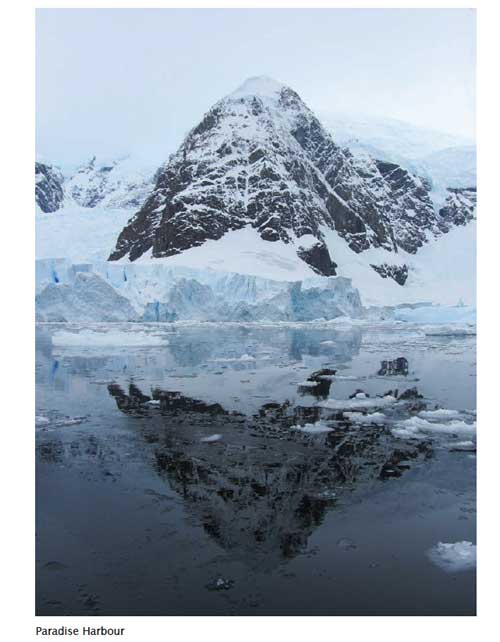
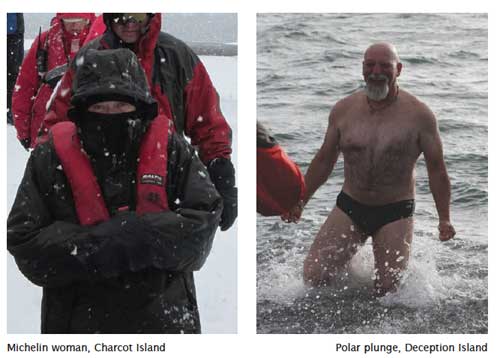
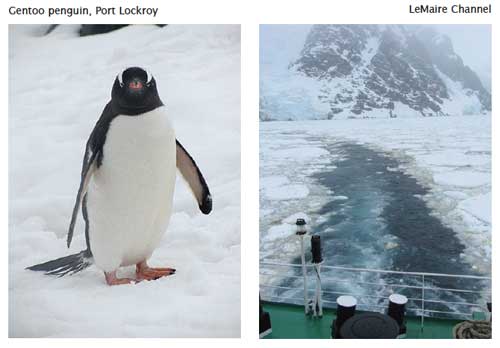
Brian: Will I or won’t I?
Today is the day for the polar plunge where crazy people strip off and dive into the freezing waters of Teflon Bay on Deception Island. I’m still not sure if I’ll do it as we gear up and head into the zodiacs. Shirl thinks I’m crazy, and she could be right, but I’ll only ever have this one chance.
Shirley: I can’t think of anything worse — getting out of very warm clothing and leaping into the freezing water. Brian is very keen. Father and son from Terrigal, Rod and Matt are going to do it. There are about 40 of the 120 odd passengers who think it’s a good idea. Both the ship’s doctors are on the beach while the plungers swim, probably just in case something goes wrong. I don’t know if that should be comforting or worrying. It’s quite hilarious hearing the squeals and screams as people rush in. There is no point inching in. Just make a dash for it. I still don’t get it.
•
Brian: Rod and Matt are wearing their red and yellow lifesaving caps with their arctic gear. This looks a little incongruous. Men and women of all ages strip off to their bathers or undies and dash into the water.
Bugger it. It’s now or never.
Off with the warm jacket, rubber boots, a bit of a struggle getting the pants off and I’m down to the budgie smugglers. It’s too cold to stand around too long — the wind is biting — so I make a dash for the water and dive in. It’s not too bad. In fact it feels warmer than the air temperature, but it’s still –1°C. A quick swim around and it’s back on shore. The wind is chilling me to the bone and I can’t feel my hands or feet. I dress as quickly as I can and jump into the first zodiac back to the ship. In the mudroom there’s the Norwegian equivalent of Slivovitz for the crazy swimmers. It’s firewater and burns all the way down, but it’s just what I needed.
It’s a momentous occasion. One hundred years to the day that Roald Amundsen won the race to be the first to the South Pole I took my first and ONLY polar plunge.
The certificate signed by the expedition leader and the ship doctor says that I must have been suffering a form of polar madness that often occurs close to the Antarctic Circle. Teflon Bay is at Latitude 62° 55.4’ South and Longitude 060° 38.6’ West and the Southern Ocean temperature was –1.5°C.
Shirley: Blue skies are avoiding us. Today it’s snowing as we head to the Gerlache Straits. The good news is the seas are calm and the wind is a mild Force 2. There’s a warning though — the decks are covered in ice and snow and its dangerous.
Our first outing today is a zodiac trip around Paradise Bay. It’s snowing and it’s bloody cold. Our gear gets wet even though we haven’t made a landing. It’s hard to ignore the cold even though we’re surrounded by amazing icebergs and penguins galore.
•
There’s a little piece of England down here, at Port Lockroy Base A. One of Antarctica’s most historic locations, it was a secret British army base during World War II, established to prevent the enemy getting a foothold or to crack enemy codes, depending on who you believe. It is now a scientific research station and museum.
Volunteers look after the museum during the summer months and conduct studies of the Gentoo penguins. There are penguins that nest under the museum and interact with humans and another group on the other side of the island that don’t. They are trying to see if there is a difference in their breeding habits.
The history is interesting but the great drawcard for me is the shop. It’s so English. As well as the normal T-shirts and windcheaters, there are Antarctic themed tea towels and cross-stitch patterns, stands for your used teabags and all manner of kitsch souvenirs. I’m in heaven. I queue up to make my purchases and behind me is one of the ship’s doctors. He has an Antarctic tartan knee rug tucked under his arm.
After a bit of shopping we wander around the museum seeing how basic the conditions were for the workers down here during the 50s and 60s: wooden shacks, bunk beds and meagre supplies. It must have been a hard life during the bright summer months and even harder during the depressing darkness of winter. And bloody freezing.
As well as the shop there’s the post office. We post a card home. The cards leave here on a cruise ship to the Falkland Islands, and then the British military fly them to London for dispatch to all points around the world by the Royal Mail. Ah, only the British.
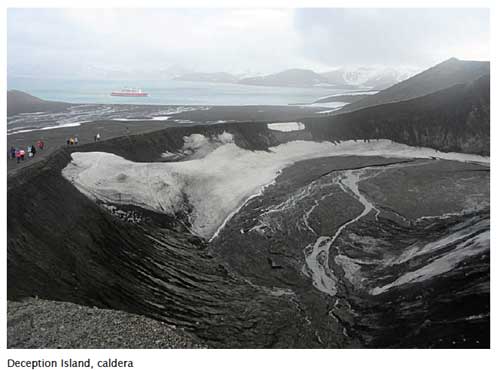
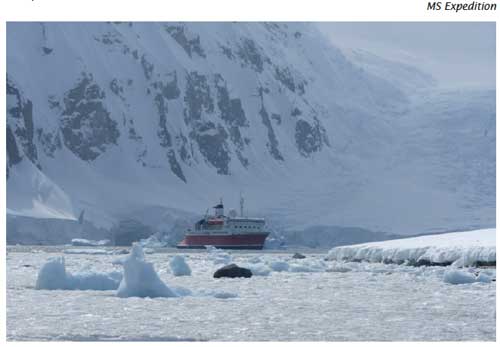
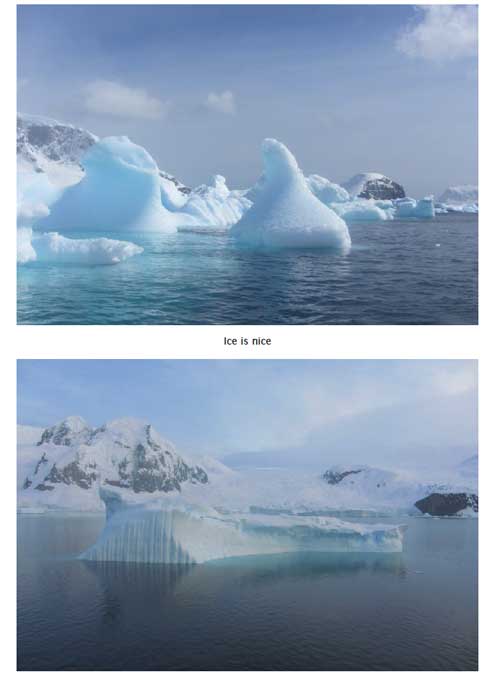
The girls who live here for the summer join us on board for a hot shower and dinner. They also replenish their fresh water supplies. You wouldn’t think they’d run out of fresh water with all that snow around, but the penguins contaminate the snow.
•
Heading back to the MS Expedition in the zodiac it’s impossible to ignore the huge iceberg that has attached itself to the front of the ship. The captain is embarrassed that he is an ‘ice magnet’ and has a hell of a time getting the ship away from this massive chunk of ice. He sends the crew in the zodiacs to try and push if off. That doesn’t work, so he uses the thrusters to back away from it.
He hopes no one will put it on YouTube!
Brian: As if the wraparound iceberg wasn’t enough, we head right into the ice to attempt to get through the Lemaire Channel on our way to the Antrarctic Circle. The entrance is narrow and it’s a tricky piece of navigation. We can’t get through the channel because of the pack ice.
Talking to Captain Asparuh on the bridge I try and encourage him to get closer, but the ice rating of the ship, a converted car ferry, isn’t high enough. Shirl and I will cross the Arctic Circle on this trip, if everything goes to plan. There would be real synchronicity if we cross the Antarctic Circle, but it’s not to be. The weather conditions are against us this early in the Antarctic summer.
This is the furthest south we will go — 65º 08.46’ S 064º 03.79’ W — just 84 miles from the Antarctic Circle. The ice is too thick. Ah, so close, but yet so far.
It’s amazing to watch as the ship is swallowed by the ice. Like the glaciers we saw in South America, this ice seems to be a living entity. The captain kills the engines and you can hear the ice cracking as we head further into what they call the ice garage. A seal relaxing on some flat ice decides we’re too close for comfort and glides into the water.
It is a breathtaking sight. No wonder the crew is passionate about Antarctica and everything it has to offer.
•
Sunday, December 18 is a special day — today we land on the continent of Antarctica. All our other landings have been on the islands and not the white continent itself. It’s 2°C, there is a bit of sun and the water is 1°C. It’s a glorious day and the snow and sky look just like the brochures — white snow glistening in the sun with clear blue skies.
The Australian flag and our mascots Ken and Millie come on shore with us. We declare this piece of snow for Australia. It’s a momentous day of ice and snow, and industrious little penguins and seals resting on the ice floes.
At dinner those who have now set foot on the seven continents get to drink seven shots. Alas we have only set foot on six of the seven. We have yet to visit Africa. Maybe we should go back to Australia that way. I wonder what Shirl will make of that idea?
•
The fog descends for the last zodiac cruise and it’s a mighty trip. Matt, our zodiac driver, heads straight out into the fog, assuring us there is a glacier out there. On the way we see elephant seals. These huge creatures lumber around on the dirt and cuddle up together in massive piles of blubber.
At the glacier we see a massive iceberg. Matt says, ‘Ice is nice but it’s squat without penguins’. He guns the zodiac and on the other side are some Gentoos walking up the snow on top of the iceberg.
As we head back to the ship, it looms up out of the fog, looking like a ghost ship behind the rocky outcrops. This is the perfect way to end our last day in the Antarctic waters. Tonight, after dinner, we will hit the Drake Passage.
Shirley: Antarctica has been even better than we expected. The sights as we skim across the water in the zodiacs are incredible: seals; Magellan, Gentoo, Chinstrap and ice living Adelie penguins; whales; gulls, skuas and petrels. The ink black water is crystal clear and reflects the black hills, white snow, blue ice and sky. The ice has my heart. There are icebergs bigger than our ship and tiny ones where the Wendell, crabeater, elephant and the awesome leopard seal take a break from the sea. The blue of the ice is an optical illusion that creates the purest colour. I could come back here year after year.
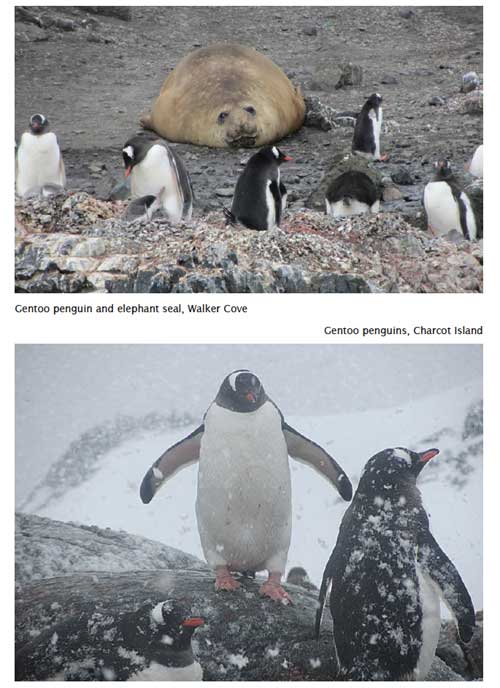
Despite this, dread and anxiety are the order of the evening for me as we head back to the Drake Passage. There is probably no one on board who is happier than me when the return crossing is one of the calmest the crew has experienced this season.
Back in Ushuaia we have a drink with the captain and the crew sing the MS Expedition Farewell Song, a variation of Leaving on a Jet Plane. There’s plenty of laughter and cheering and a few tears as our journey to the bottom of the world comes to an end.
•
Brian: Did I love Antarctica? You bet I did.
It brings into perspective the fact that while human beings think they rule the world, the only true ruler is nature itself and we are at her mercy. We have been fortunate to experience this place, nature in its purest form — wild, harsh, beautiful, wondrous and overwhelming.
There is an Antarctica Treaty and strict guidelines that tour operators must follow to keep this paradise on Earth as it should be. It is one of the last vestiges on Earth hardly altered by humans, and long may it remain. I want my grandchildren and their grandchildren to have the opportunity to experience this place.
•
Some ice and snow facts